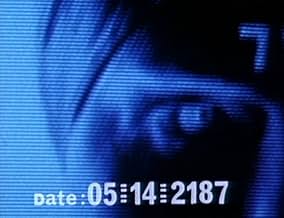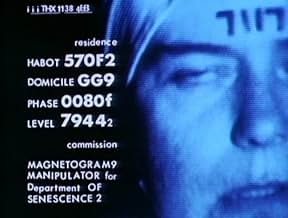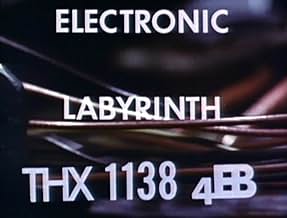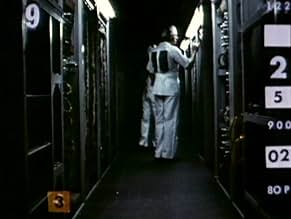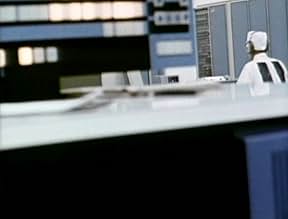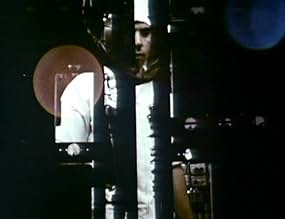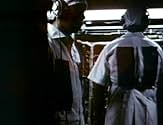Electronic Labyrinth THX 1138 4EB
- 1967
- 15 min
AVALIAÇÃO DA IMDb
6,2/10
2,8 mil
SUA AVALIAÇÃO
Adicionar um enredo no seu idiomaWhile monitored and pursued, a man races to escape through a futuristic labyrinth.While monitored and pursued, a man races to escape through a futuristic labyrinth.While monitored and pursued, a man races to escape through a futuristic labyrinth.
- Direção
- Roteiristas
- Artistas
- Prêmios
- 1 vitória no total
- Direção
- Roteiristas
- Elenco e equipe completos
- Produção, bilheteria e muito mais no IMDbPro
Avaliações em destaque
Sure it may be no-budget, sure it may be using film equipment and film stock that's not to the 'studio' standard. But, as someone who has come out of being a film student, I look at George Lucas's award-winning student short film with a good deal of awe. And Lucas, who has described himself as being a filmmaker who is split between the avant-garde and the more 'mainstream' films (the latter personified film-wise in Star Wars and Indiana Jones), goes to the extreme of his powers with his visual prowess. It is surreal in that it tries to express an idea through an unconventional means, with a story but without being stuck to it by any means. And because it's so short there's only so much time to get the message across with such little film.
Electronic Labyrinth takes just a slice- the more action packed and suspenseful slice- from what would become the feature film of THX 1138, using absolutely no dialog. That to me is a phenomenal, but very dangerous, step to take. There's always the chance, especially with young, experimental filmmakers, to go into the over-indulgent, or rather just to go in over your head with abstract concepts that just don't connect out of likely just not being well made. Here the quasi-beating over-the-head of image and sound works, because it's a film about technology, about the control of it over people, and it makes a very basic kind of statement of going against the overwhelming power of it. The hero of the film for almost all of the film does a lot of running, down corridors, down spacious, domineering spaces, leading up to a sort of bleak ending.
It may not get enough thematic ground like the feature-version does, and the lack of dialog sets a kind of gap between a viewer not ready for the combination of twistingly sci-fi visuals of the screens and numbers and videos and such. But it's got guts, and that's what I like to see in student films; the cliché that this is a "sign of things to come" is not far from the truth (ironically, after the feature-film of this, it would go more towards the mainstream for Lucas, but you never know).
Electronic Labyrinth takes just a slice- the more action packed and suspenseful slice- from what would become the feature film of THX 1138, using absolutely no dialog. That to me is a phenomenal, but very dangerous, step to take. There's always the chance, especially with young, experimental filmmakers, to go into the over-indulgent, or rather just to go in over your head with abstract concepts that just don't connect out of likely just not being well made. Here the quasi-beating over-the-head of image and sound works, because it's a film about technology, about the control of it over people, and it makes a very basic kind of statement of going against the overwhelming power of it. The hero of the film for almost all of the film does a lot of running, down corridors, down spacious, domineering spaces, leading up to a sort of bleak ending.
It may not get enough thematic ground like the feature-version does, and the lack of dialog sets a kind of gap between a viewer not ready for the combination of twistingly sci-fi visuals of the screens and numbers and videos and such. But it's got guts, and that's what I like to see in student films; the cliché that this is a "sign of things to come" is not far from the truth (ironically, after the feature-film of this, it would go more towards the mainstream for Lucas, but you never know).
George Lucas developed this film during his days in film school. It impressed his teachers and eventually gave him the courage to make "THX 1138," a full-length spin-off which was his theatrical debut and featured the talents of Robert Duvall and Donald Pleasence.
This was the basis for that spin-off, which is much shorter and doesn't feature any of the complicated themes of the semi-remake. Personally I feel the remake is far superior because of its advanced storytelling, visuals, acting, and love story, but that's just me (and I have a feeling most people probably like the remake better, too, but...).
The point remains that without this, George Lucas might never have impressed anyone. He might never have made "THX 1138." He might never have made "American Graffiti," and there would be no "Star Wars" because he wouldn't have convinced anyone to lend him the money.
There would be no THX sound on DVDs. There would be no ILM. There would be no Indiana Jones, no Luke Skywalker, nothing.
Hard to imagine, isn't it? All because of one small 15-minute, cheaply-produced short film...
This was the basis for that spin-off, which is much shorter and doesn't feature any of the complicated themes of the semi-remake. Personally I feel the remake is far superior because of its advanced storytelling, visuals, acting, and love story, but that's just me (and I have a feeling most people probably like the remake better, too, but...).
The point remains that without this, George Lucas might never have impressed anyone. He might never have made "THX 1138." He might never have made "American Graffiti," and there would be no "Star Wars" because he wouldn't have convinced anyone to lend him the money.
There would be no THX sound on DVDs. There would be no ILM. There would be no Indiana Jones, no Luke Skywalker, nothing.
Hard to imagine, isn't it? All because of one small 15-minute, cheaply-produced short film...
This was the student film that George Lucas did way before he became successful in cinema.
4 years before he made the THX 1138 film. He created this short film which is very well written.
The whole short has to do with THX, an individual trap in a sick twisted world. Which he tries escape throughout the whole short.
It's very different from the full length film. But those who are curious to know what the earlier version is. This one's definitely an early version.
All great director start somewhere in their careers. And this is a fine example of a student film.
It's available on the THX Director's Cut DVD.
4 years before he made the THX 1138 film. He created this short film which is very well written.
The whole short has to do with THX, an individual trap in a sick twisted world. Which he tries escape throughout the whole short.
It's very different from the full length film. But those who are curious to know what the earlier version is. This one's definitely an early version.
All great director start somewhere in their careers. And this is a fine example of a student film.
It's available on the THX Director's Cut DVD.
While monitored and pursued, a man races to escape through a futuristic labyrinth.
Lucas had had an idea for a long time "based on the concept that we live in the future and that you could make a futuristic film using existing stuff". Fellow USC students Matthew Robbins and Walter Murch had a similar idea which Robbins developed into a short treatment, but Robbins and Murch lost interest in the idea, whereas Lucas was keen to persist.
Because of the USC's Navy connection, Lucas was able to access filming locations which would not otherwise have been available to him: the USC computer center, a parking lot at UCLA, the Los Angeles International Airport, and the Van Nuys Airport. Much of the filming was done at night, with some at weekends.
This film's value is in the fact it is a root. By itself, it is a very good student film, but still just that: a short student film. But we know what came of this. It turned into a feature-length film, it caught the attention of Steven Spielberg, and soon we had "Star Wars" and "Indiana Jones". Without this, we would have none of that, and Harrison Ford would be unemployed.
Lucas had had an idea for a long time "based on the concept that we live in the future and that you could make a futuristic film using existing stuff". Fellow USC students Matthew Robbins and Walter Murch had a similar idea which Robbins developed into a short treatment, but Robbins and Murch lost interest in the idea, whereas Lucas was keen to persist.
Because of the USC's Navy connection, Lucas was able to access filming locations which would not otherwise have been available to him: the USC computer center, a parking lot at UCLA, the Los Angeles International Airport, and the Van Nuys Airport. Much of the filming was done at night, with some at weekends.
This film's value is in the fact it is a root. By itself, it is a very good student film, but still just that: a short student film. But we know what came of this. It turned into a feature-length film, it caught the attention of Steven Spielberg, and soon we had "Star Wars" and "Indiana Jones". Without this, we would have none of that, and Harrison Ford would be unemployed.
Although very little happens in terms of action in George Lucas's best-remembered student film "Electronic Labyringth THX 1138 4EB", there is already plenty to be admired in the visual look alone, considering the assumed small budget they had to work with at the USC. As in all of Lucas's early shorts, the film is very well-made with lots of good craft on display: the locations and costumes, while not overly elaborate, give enough of an atmosphere to suggest an otherworldly environment. The editing is skillful as well, being an almost abstract mishmash of shots and snippets of audio which add to the intensity of the action a little, although it certainly doesn't possess the type of intensity Hollywood would make use of. That aside, the plot itself is rather skimpy and carries plenty of repetition in the images and soundtrack; to expect a greater narrative would be admittedly absurd for fifteen minutes, yet the fact that Lucas took even that long to convey what plot he had shifts the focus to the atmosphere and setting built into it, rather than specifically the plot.
The context of the story is rather unclear, although it is made more interesting simply because we are left to decipher what is happening. The film seems to be occurring in a Dystopian setting as the likes of George Orwell would come up with - a time when the higher powers have taken over, enslaving and ruling over those below them with an iron fist. In this version, the setting is an Electronic Labyrinth in a presumed future when technology has taken over to control the lives of others. The film follows a man, given the designated number 1138, as he attempts to do the unspeakable - escape the slavery of technology, running through shiny white hallways to make it out before he is destroyed by his oppressors. With consistent intercoms blaring instructions on how to stop him mixed with security cam footage and scenes of men in headsets pulling switches, the film's atmosphere is a unique one, repetitive yet oddly surreal, with enough creativity to the settings and costumes to make give it a futuristic feel. The unanswered questions are many, yet they add to the experience - so much so that I doubt I would benefit much if at all from seeing Lucas's 1971 feature film "THX 1138" which elaborates on things. Little plot definitely, yet enough to play with the viewer's mind while simultaneously giving clues through a well-built environment. Certainly remarkable for a student's work, technically and analytically speaking.
The context of the story is rather unclear, although it is made more interesting simply because we are left to decipher what is happening. The film seems to be occurring in a Dystopian setting as the likes of George Orwell would come up with - a time when the higher powers have taken over, enslaving and ruling over those below them with an iron fist. In this version, the setting is an Electronic Labyrinth in a presumed future when technology has taken over to control the lives of others. The film follows a man, given the designated number 1138, as he attempts to do the unspeakable - escape the slavery of technology, running through shiny white hallways to make it out before he is destroyed by his oppressors. With consistent intercoms blaring instructions on how to stop him mixed with security cam footage and scenes of men in headsets pulling switches, the film's atmosphere is a unique one, repetitive yet oddly surreal, with enough creativity to the settings and costumes to make give it a futuristic feel. The unanswered questions are many, yet they add to the experience - so much so that I doubt I would benefit much if at all from seeing Lucas's 1971 feature film "THX 1138" which elaborates on things. Little plot definitely, yet enough to play with the viewer's mind while simultaneously giving clues through a well-built environment. Certainly remarkable for a student's work, technically and analytically speaking.
Você sabia?
- CuriosidadesThe "EB" referred to in the title means "earth born" according to the original script writer.
- Erros de gravaçãoDuring the credits where George Lucas is mentioned as the director, a piece of transparent tape is visible on the left side of the screen.
- ConexõesFeatured in Omnibus: George Lucas - Flying Solo (1997)
Principais escolhas
Faça login para avaliar e ver a lista de recomendações personalizadas
Detalhes
- Data de lançamento
- País de origem
- Idioma
- Também conhecido como
- THX 1138 4EB
- Locações de filme
- Empresa de produção
- Consulte mais créditos da empresa na IMDbPro
Contribua para esta página
Sugerir uma alteração ou adicionar conteúdo ausente

Principal brecha
By what name was Electronic Labyrinth THX 1138 4EB (1967) officially released in India in English?
Responda
